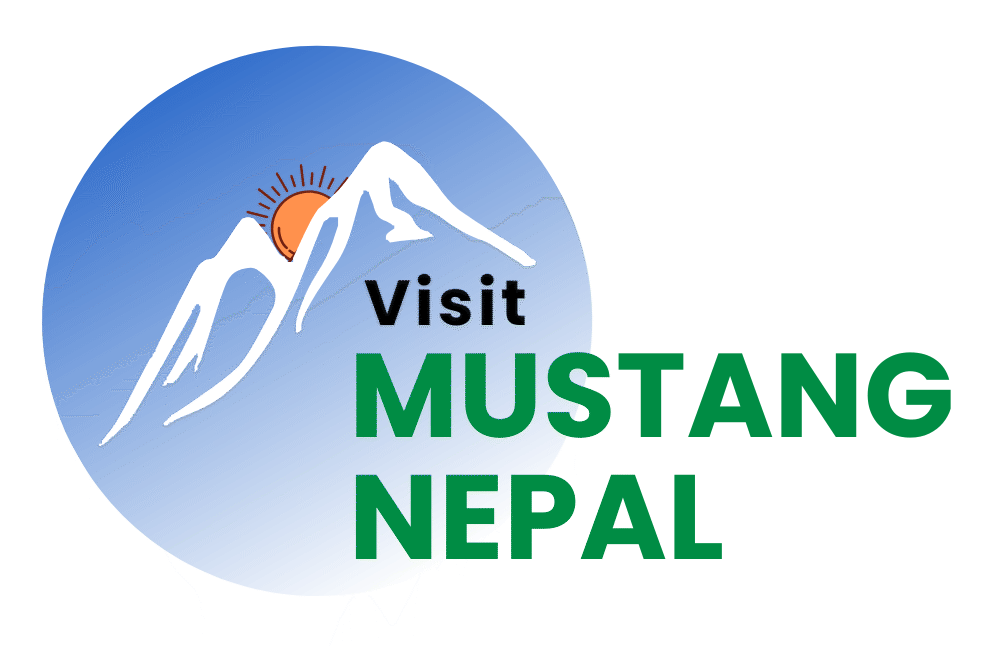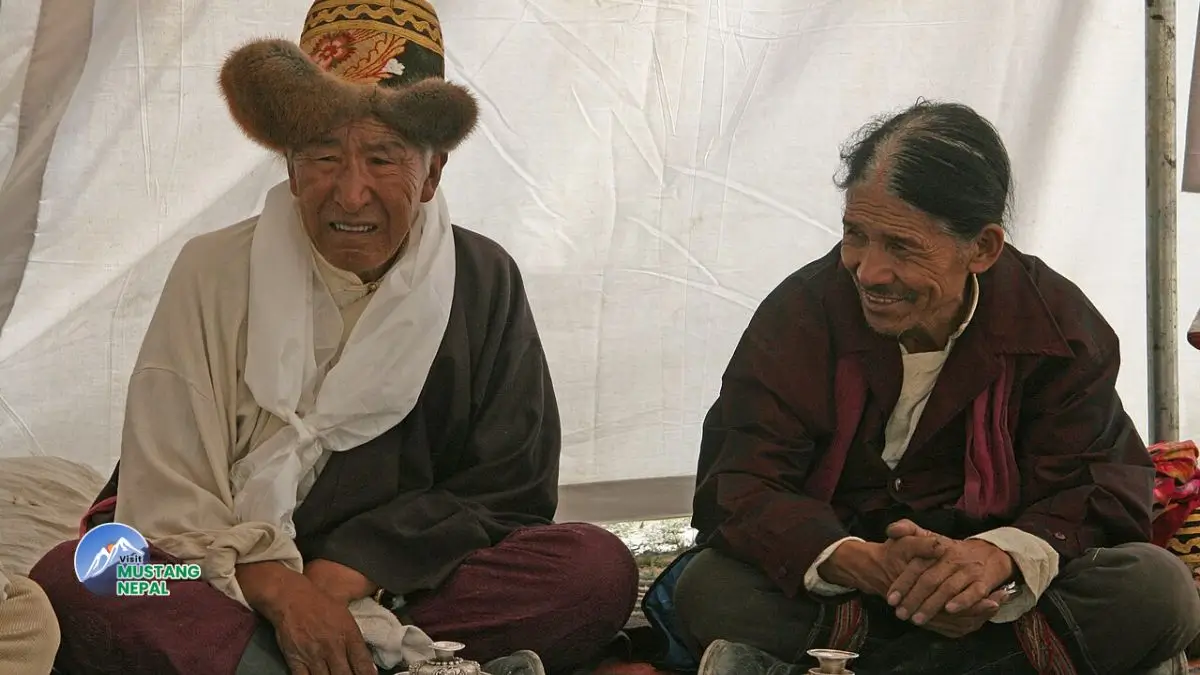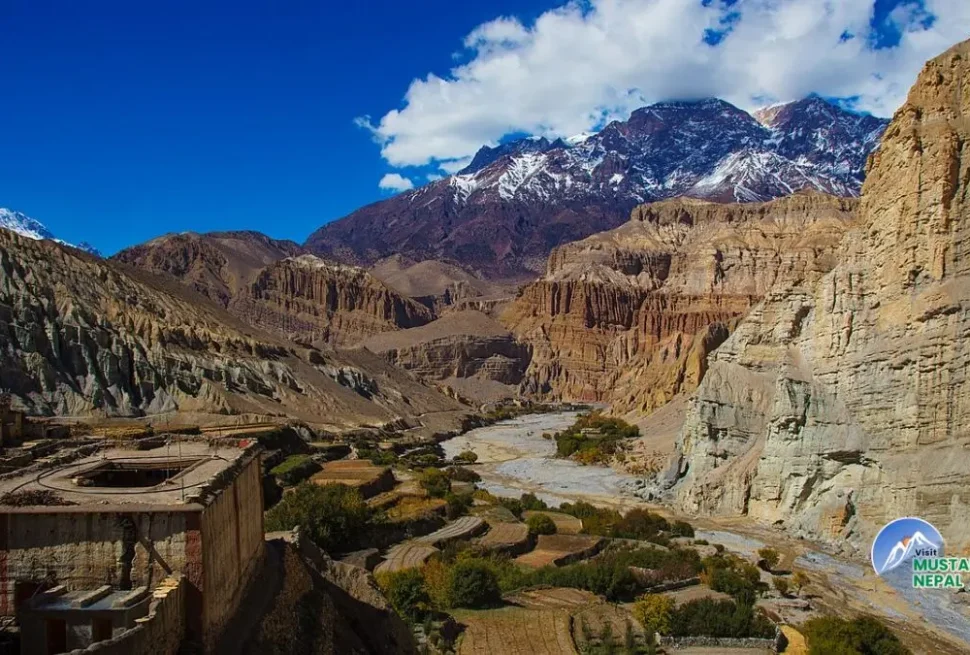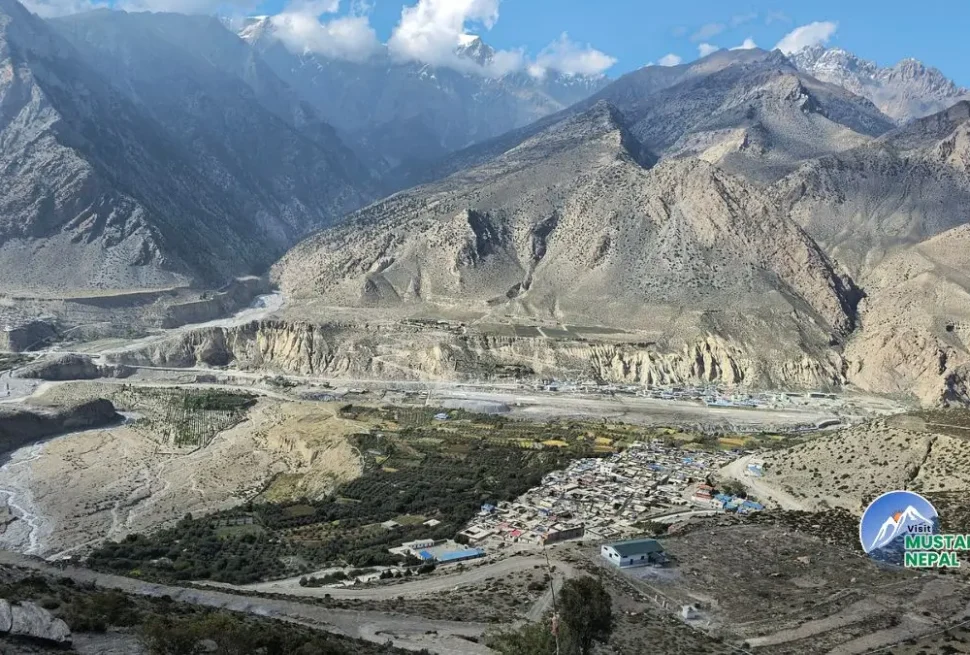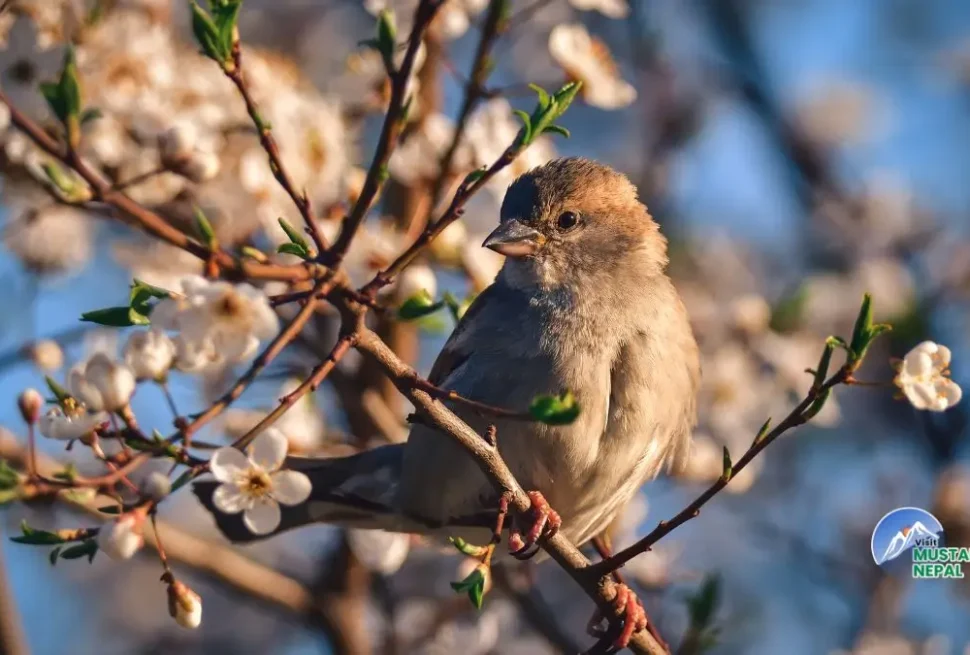Walking through Mustang feels like stepping into a living mueseum where every stone tells a story. Nestled high in the remote mountains of Nepal, Mustang is a special district known as the “Forbidden Kingdom” because it was closed to outsiders until the early 1990s. The people of Mustang have kept their ancient Tibetan culture and traditions alive for hundreds of years.
Their land is full of red cliffs, deserts, and walled villages like Lo Manthang, the old kingdom’s capital. Mustang’s people deeply follow Buddhism, celebrate colorful festivals like the Tiji Festival, and live a simple life connected to their history and nature.
The language, traditions, and beliefs of this region are heavily affected by Tibetan culture, making it feel like a tiny part of Tibet inside Nepal. As one of the most culturally diverse and unique locations in the Himalayas, Mustang has managed to preserve its distinct way of life despite its long history of isolation and remoteness. This area provides a window into a kingdom rich in religious beliefs, history, and classic alpine beauty.
Quick Facts About Mustang People
- Location: Upper & Lower Mustang, Nepal
- Min Ethnic Groups: Thakali, Lopa, Gurung
- Religion: Tibetan Buddhism & Bon
- Famous Festivals: Tiji, Yartung, Toranlha
- Popular Foods: Thukpa, Tsampa, Yak meat
- Must-visit Village: Lo Manthang
Introduction to the People of Mustang
Mustang is a district in northern Nepal that sits high in the Himalayas. Because it’s surrounded by tall mountains and difficult terrain, the people here have lived in isolation for centuries. This isolation has helped them preserve their special way of life, which is very different from other parts of Nepal.
The geography of Mustang is harsh but beautiful. It’s a desert-like landscape with red cliffs, deep valleys, and snow-capped peaks all around. Living in such a challenging environment has made the people of Mustang strong, resourceful, and closely connected to nature. They have developed their own unique identity that blends Tibetan and Nepalese influences.
Ethnic Groups of Mustang
Several different groups of people call Mustang home, each with its own customs and traditions.
The Thakali People
Thakali → Famous for Thakali Khana set
The Thakali are one of the main groups in Mustang. They are famous traders who have been buying and selling goods between Tibet and Nepal for hundreds of years. The Thakali people are organized into different clans, kind of like large extended families. They’re known for being excellent at business and for their delicious food.
The Loba (Lopa) Community
The Loba people live mainly in Upper Mustang and have very strong connections to Tibetan culture. In Loba villages, you’ll often see prayer flags hanging from every rooftop, fluttering against the barren red cliffs.
Many of them are farmers who grow crops like barley and raise animals like yaks. Their way of life hasn’t changed much over the centuries, and they still follow many ancient Tibetan traditions.
Other Ethnic Groups:
Mustang is also home to Gurung, Magar, Tamang, and Dalit communities. Each group brings its own customs, languages, and skills to the region. Despite their differences, all these communities live together peacefully and often help each other during festivals and important events.
| Ethnic Group | Main Language | Famous Festival | Main Occupation |
| Thakali | Thakali | Toranlha | Trading, hospitality |
| Loba | Lhopa | Tiji Festival | Farming, herding |
| Gurung | Gurung | Dashain | Agriculture |
| Magar | Magar | Maghe Sankranti | Farming |
Language and Communication of People of Mustang
The people of Mustang speak several different languages. Nepali is the official language of Nepal, so most people can speak it. However, many also speak Tibetan dialects like Lhopa, which sounds very similar to the language spoken in Tibet. The Thakali people have their own language called Thakali.
Because Mustang was historically connected to Tibet through trade, Tibetan culture has had a huge influence on how people communicate. Many religious terms, place names, and everyday words come from Tibetan. Today, people are working hard to keep these local languages alive by teaching them to children and using them in daily life. Some can speak English in the tourist areas.
Religion and Spiritual Life
“Tashi Delek” = good wishes in Tibetean
Most people in Mustang follow Tibetan Buddhism, which shapes their daily lives in important ways. Buddhism teaches people to be kind, peaceful, and respectful of all living things. You’ll see colorful prayer flags fluttering in the wind and hear the sound of prayer wheels spinning as people walk by.
In the village of Lubra, some people still practice an ancient religion called Bon, which existed in Tibet before Buddhism arrived. Bon has its own unique rituals and beliefs about nature spirits and the power of the natural world.
Stepping inside Thubchen Gompa feels like entering a time capsule, with 15th-century murals glowing in the candlelight.
Many young men and women in Mustang become monks and nuns, dedicating their lives to studying Buddhist teachings and helping their communities. Monasteries (places where monks live) are centers of learning and spiritual practice. People gather there to pray, meditate, and celebrate religious festivals together.
Culture and Traditions of the People of Mustang
The people of Mustang celebrate several colorful festivals throughout the year that bring entire communities together.
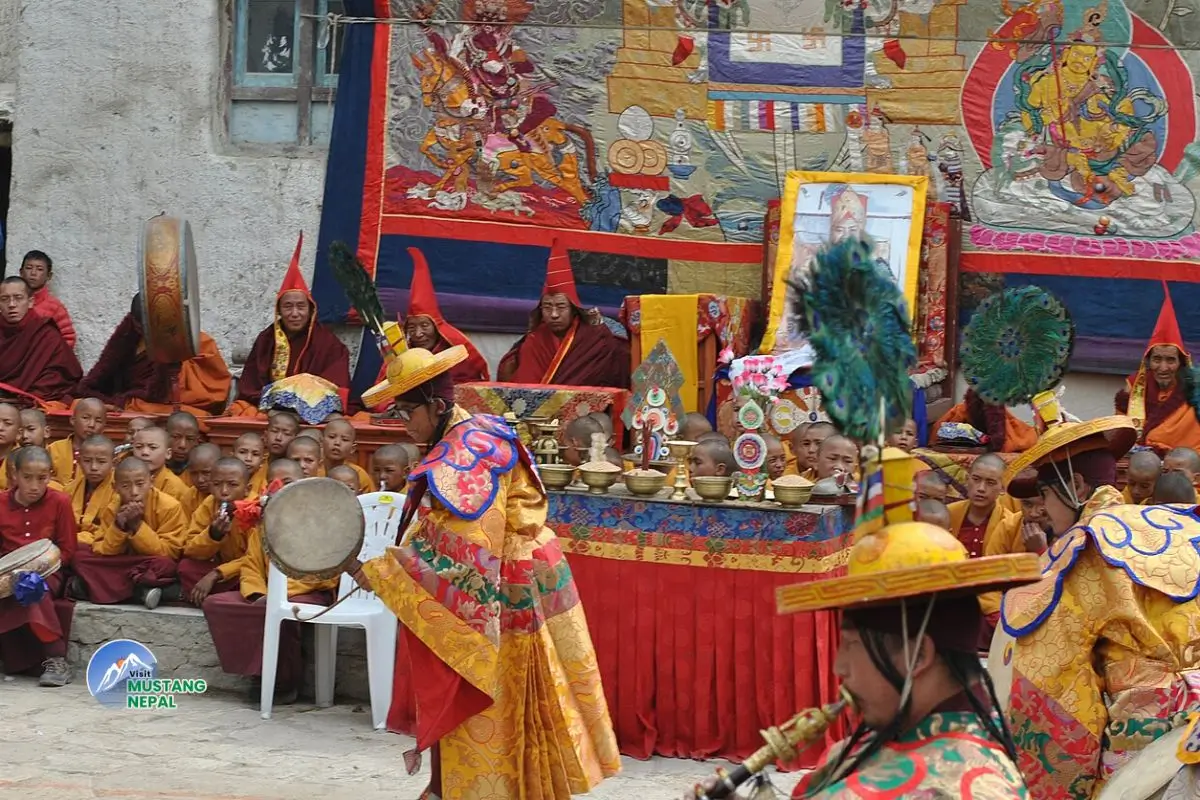
Festivals in Mustang
Mustang is a culturally rich region in Nepal. It is a home to vibrant festivals that reflect its deep-rooted traditions and close connection to nature. These festivals not only celebrate the changing seasons and agricultural cycles but also reinforce community bonds and spiritual beliefs through colorful rituals, music, and dance.
- Tiji Festival: This is the most famous festival in Mustang, celebrated for three days in May. It tells the story of a demon being defeated by a god, symbolizing good winning over evil. Monks perform special dances wearing elaborate masks and costumes.
The Tiji Festival in Lo Manthang is a three-day celebration with masked monk dances that tell the story of Dorje Jono, a deity who defeated evil to protect the kingdom. It brings the community together to pray for peace and happiness.
- Toranlha: This is the Thakali New Year celebration with feasts, dancing, and family gatherings.
- Falo: A harvest festival where people thank nature for a good crop season.
- Yartung Festival, or Horse Festival: This marks the end of the monsoon and includes horse races, archery, music, and dance. The whole village joins in to celebrate and pray for a good harvest.
Want to witness the Tiji Festival in person? Reserve your Mustang journey early; permits are limited.
Traditional Clothing and Arts
People in Mustang wear beautiful traditional clothes, especially during festivals. Women wear long robes called chubas with colorful aprons, while men wear similar robes with special hats. The clothes are often decorated with intricate patterns and bright colors.
Music and dance are very important in Mustang culture. People sing folk songs that tell stories about their ancestors, love, and the beauty of their homeland. Traditional instruments include drums, flutes, and singing bowls.
Mustang Cuisine
The food in Mustang is hearty and warming, perfect for the cold mountain climate. Some popular dishes include:
- Thukpa: A noodle soup with vegetables and sometimes meat
- Tsampa: Roasted barley flour mixed with butter tea
- Yak meat: Dried or cooked meat from yaks, which are like large, furry cows
- Butter tea: A salty tea made with yak butter that gives people energy
- Gundruk: Fermented leafy vegetables that provide vitamins during winter
- Khumar (fermented millet beer)
- Buckwheat pancakes (fing)
- Marpha apple brandy (raksi)
Did you know? Marpha apples are so famous that Mustang is called the ‘Apple Kingdom of Nepal’.
Community Gatherings and Customs
Local people also gather regularly for smaller religious ceremonies at monasteries like Chode Gompa. These events keep Mustang’s Tibetan Buddhist culture alive and strengthen community bonds.
Villages and Architecture of Mustang
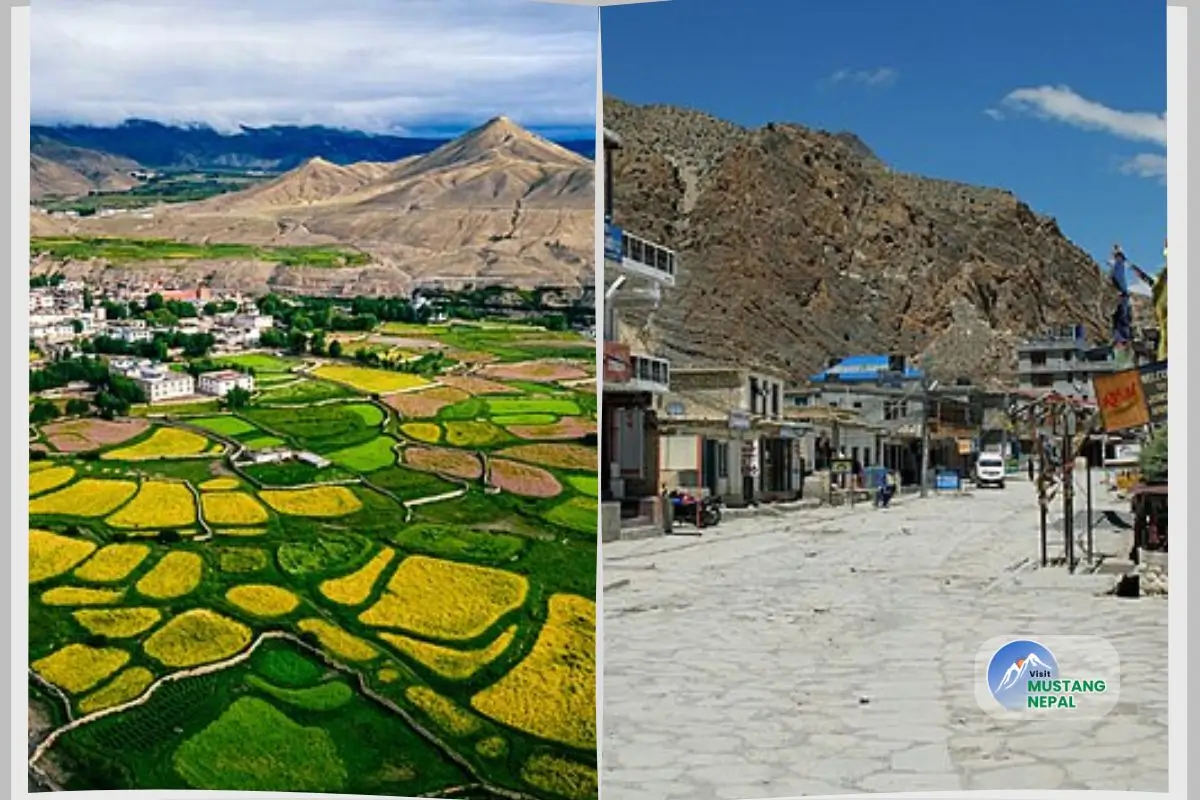
The villages of Mustang look like a step back in time. It is the blend of ancient history with Tibetan culture. The most famous is Lo Manthang, a walled city that was once the capital of the Kingdom of Lo. Its narrow streets, mud-brick houses, and the royal palace make visitors feel like they’ve entered a medieval world.
| Ancient Mustang | Modern Mustang |
| Barley & yak-based farming | Apple orchards & tourism jobs |
| Isolated, limited trade | Connected by roads & remittances |
| Nomadic herding common | Migration to cities & abroad |
Mustang consists of two main regions with different landscapes and settlement styles. Upper Mustang features walled, Tibetan-style villages with traditional flat-roofed houses made from mud bricks. These homes are built to stay warm in winter and cool in summer, fitting the dry mountain climate. In contrast, Lower Mustang has greener valleys filled with apple orchards and more modern trading towns.
Key Villages:
- Lo Manthang: The ancient walled capital with a royal palace and important monasteries
- Jomsom: A busy trading town and gateway to Mustang
- Kagbeni: A medieval village that guards the entrance to Upper Mustang
- Marpha: Famous for its apple orchards and traditional architecture
Houses in Mustang are built from mud bricks and have flat roofs. This style of building works well in the dry climate and helps keep homes warm in winter and cool in summer. Many buildings are hundreds of years old, but are still in good condition because the dry air preserves them well.
The monasteries in Mustang are architectural treasures filled with ancient paintings, statues, and manuscripts. Some contain artwork that is over 600 years old, making them like outdoor museums of Tibetan culture.
Dreaming of exploring Mustang’s timeless villages? Book your cultural trek today.
Economy and Livelihood
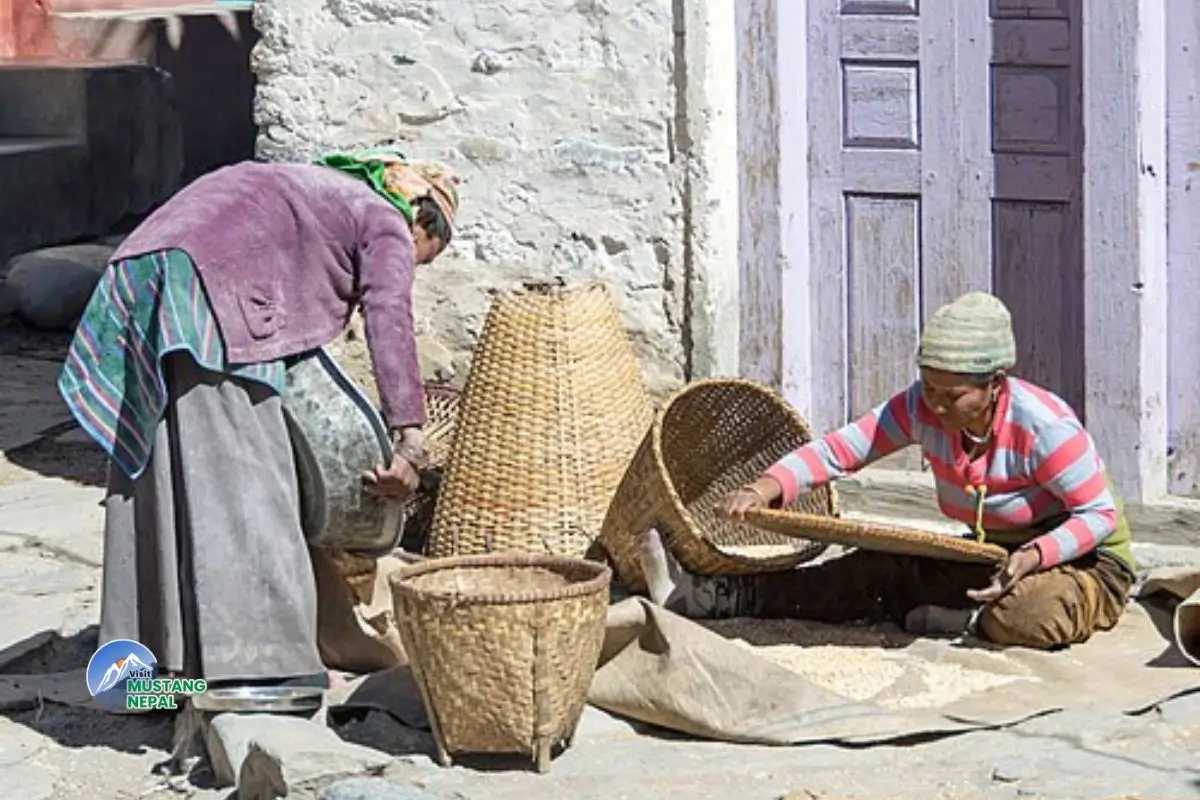
Making a living in Mustang requires creativity and hard work. The economy is based on several main activities:
- Agriculture: Despite the harsh climate, people in Mustang are skilled farmers. They grow apples, apricots, and barley using ancient irrigation systems. The apples from Marpha are especially famous throughout Nepal for their sweetness and quality.
- Trade with Tibet: For centuries, Mustang has been an important trading route between Nepal and Tibet. Traders would carry goods like salt, wool, and tea across high mountain passes. While this trade has decreased due to political changes, some trading still continues.
- Migration and Remittances: Many young people from Mustang move to bigger cities or even other countries to find work. They send money back home to help their families, which has become an important source of income for many households.
- Tourism: In recent years, tourism has become increasingly important. Visitors come to experience the unique culture, beautiful landscapes, and spiritual atmosphere of Mustang.
Natural Environment and Lifestyle
Life in Mustang is closely connected to the natural environment. The landscape includes dramatic red cliffs, green river valleys, and snow-covered peaks. The Kali Gandaki River cuts through the region, creating fertile areas where people can farm.
Seasonal Life in Mustang:
- Winter (Dec – Feb): Villagers stay indoors, weave woolen clothes, dry meat, and make handicrafts.
- Spring (Mar – May): Time for sowing crops, repairing irrigation canals, and celebrating the Tiji Festival.
- Summer (Jun – Aug): Farmers focus on tending fields and herding animals, while nomads move to higher pastures.
- Autumn (Sep – Nov): Harvest season with community gatherings, Yartung Festival (horse racing), and preparation for winter.
In Mustang, a normal day starts before the sun rises. In local monasteries or little home shrines, residents light butter candles at dawn while muttering prayers as the Himalayan winds stir the prayer flags outside.
Soon after, women and men ride yaks or mules to the fields, and children dressed in woolen clothing make their way to school down dusty, winding paths. Families congregate by the fire in the evening to share stories and sip salty butter tea as the stars shine brightly overhead.
Some people in Mustang still live as nomads, moving their herds of yaks, sheep, and goats to different pastures depending on the season. Others live in permanent villages but still change their activities based on the weather and seasons.
In winter, when it’s very cold and snowy, people focus on indoor activities like weaving, making crafts, and maintaining their homes. Spring and summer are busy times for farming, trading, and celebrating festivals. Autumn is harvest time, when families work together to gather crops and prepare for winter.
Did You Know?
- Mustang gets over 300 days of sunshine a year, making it one of the driest yet brightest places in Nepal.
- Lo Manthang, Mustang’s walled city, sits at an altitude of 3,840 meters, where barley is one of the few crops that grows.
- Many families still keep yak herds, which provide milk, meat, wool, and transport an entire lifestyle in one animal!
Final Thoughts
The people of Mustang are indeed maintaining a traditional way of life. They have managed to preserve their unique culture, traditions, and religious beliefs in spite of the challenges of living in one of the most remote areas on the planet. Their story shows how communities keep their traditions while also adapting to today’s world.
As more you learn about Mustang, it’s critical that you respect the nature and culture of the area. In addition to helping the local economy, responsible tourism can guarantee that future generations will be able to appreciate and learn from this amazing “Forbidden Kingdom.”
When visiting Mustang, respect local customs, support homestays, and leave no trace so this Forbidden Kingdom remains preserved for future generations. Ready to experience Mustang’s timeless culture and landscapes? Plan your journey with Visit Mustang Nepal and step into the Forbidden Kingdom today.
FAQ’s
Who are the main ethnic groups in Mustang?
The main ethnic groups in Mustang are the Thakali and Lopa people, who have Tibetan ancestry and maintain rich cultural traditions. These communities are known for their unique customs, language, and Buddhist heritage.
What languages are spoken in Mustang?
The primary languages spoken in Mustang are Tibetan and Nepali, with local dialects such as Lhopa also widely used. English is increasingly spoken in tourist areas.
When is the Tiji Festival celebrated?
The Tiji Festival is celebrated annually in late spring, usually in May, and lasts for three days. It is a vibrant Buddhist ritual symbolizing the victory of good over evil, attracting many visitors.
What traditional foods should visitors try?
Visitors should try traditional Mustang foods like Thukpa (noodle soup), Tsampa (roasted barley flour), and Yak meat dishes. Butter tea and local barley beer are also popular beverages.
Which villages and monasteries are a must-visit?
Must-visit villages include Lo Manthang, the ancient walled capital, and Kagbeni, a gateway to Upper Mustang. Important monasteries are Chhairo Gompa and Thubchen Gompa, known for their historic murals and spiritual significance.
Do you need a permit to visit Upper Mustang?
Yes, visiting Upper Mustang requires permits. Trekkers must obtain a Restricted Area Permit (RAP), which costs around $500 for the first 10 days and $50 for each additional day, along with an Annapurna Conservation Area Project (ACAP) permit, which costs about $22 per person.
How high is Lo Manthang?
Lo Manthang, the walled city and former capital of the Kingdom of Mustang, is situated at an altitude of approximately 3,800 meters (12,500 feet) above sea level.
Is Mustang safe for solo travelers?
Mustang is generally considered safe for solo travelers, especially those who are experienced trekkers and take necessary precautions. The region is remote but welcoming, with a low crime rate, though it’s advisable to travel with a guide or in a group for added safety and ease of navigation.
